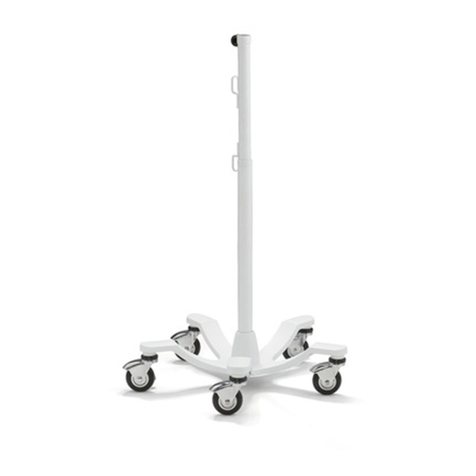
rev. 3/10/2015 HU-C, Manual
Copyright 2015 Vestil Manufacturing Corp. Page 2 of 11
SIGNAL WORDS:
This manual uses SIGNAL WORDS to indicate the likelihood of personal injuries, as well as the probable
seriousness of those injuries, if the product is misused in the ways described. Other signal words call attention to
uses of the product likely cause property damage.
The signal words used appear below along with the meaning of each word:
Identifies a hazardous situation which, if not avoided, WILL result in DEATH or
SERIOUS INJURY. Use of this signal word is limited to the most extreme
situations.
Identifies a hazardous situation which, if not avoided, COULD result in DEATH or
SERIOUS INJURY.
Indicates a hazardous situation which, if not avoided, COULD result in MINOR or
MODERATE injury.
Identifies practices likely to result in product/property damage, such as operation that
might damage the product.
Each person who assembles, installs, uses, or maintains this product should read the entire manual in advance
and fully understand the directions. If after reading the manual you do not understand an instruction, ask
your supervisor or employer for clarification, because failure to adhere to the directions in this manual
might result in serious personal injury.
Hazards of use:
Vestil strives to identify foreseeable hazards associated with the use of its products. However, material handling is
dangerous and no manual can address every conceivable risk. The end-user ultimately is responsible for exercising
sound judgment at all times.
Electrocution might result if any part of the rack system or items or materials placed on the rack contacts
electrified wires. DO NOT install the rack in a location where contact with electrified wires will occur.
If this product is used or assembled improperly or carelessly, people in the area might sustain serious
personal injuries or even be killed. ALWAYS use the product properly:
Failure to read and understand the entire manual before assembling, installing, loading or servicing the
product constitutes misuse.Read the manual to refresh your understanding of proper use and maintenance
procedures as necessary.
DO NOT exceed the maximum rated load.
Inspect the rack periodically (AT LEAST once per month). DO NOT continue to use the rack if the inspection reveals
structural damage. Examples of structural damage include: 1) warped, deformed, or damaged posts (uprights) or base
frame members; 2) cracked welds; 3) enlargement of bolt holes, etc.; 4) corrosion, severe wear, or other condition that
affects the ability of the product to support applied weight; 6) damaged, deformed or cracked braces or cross bars.
Immediately tag out the rack, unload it completely, and replace each part that fails to pass an inspection. DO NOT use
the product until it is fully restored to normal condition. ONLY use manufacturer-approved replacement parts.
DO NOT use the product if any unusual noise or movement is observed. If a malfunction occurs, completely unload
the rack and remove it from service. Notify your supervisor or maintenance personnel about the issue.
All loads stored on the rack must fit within the dimensions of the rack and arms. DO NOT store any load that hangs
over the rack.
DO NOT use the rack UNLESS it is securely anchored to the ground.
ALWAYS evenly distribute and center the load on the rack.
ONLY use this rack on even, level surfaces.
DO NOT remove or obscure any label. All product labels must be readable and undamaged.
DO NOT climb or sit on the rack.
DO NOT modify the rack in any way. Unauthorized modifications automatically void the limited warranty (see
p. 9) and might make the rack unsafe to use.
Proper maintenance is essential for this product to function properly and to last as long as possible.
oAlways use this product in accordance with the instructions in this manual and consistent with any training relevant
to the storage of materials on racks.
oKeep the rack clean & dry.










































